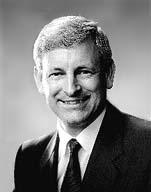“The Church in Northern Europe,” Ensign, Jan. 1994, 79–80
The Church in Northern Europe
Converts from the British Isles and northern Europe brought great strength to the growing Church in its early days. To learn about the progress of the Church in those areas now, the Ensign talked with Elder Kenneth Johnson of the Seventy, president of the Europe North Area.

Elder Kenneth Johnson
Question: What spiritual heritage has been left by the Church’s long presence in the countries of northern Europe?
Answer: We find great spiritual strength among the members there, but it is not so much a heritage as it is a gift that is being developed. The Church in northern Europe has almost a first-generation convert base. This is because during the Church’s first century and a quarter, most converts in Europe immigrated to America, where they could enjoy the blessings of a temple. In the early 1950s, for example, there were only about six thousand members left in the British Isles, despite more than a century of proselyting. The Church really began to be rooted there after the dedication of the London Temple in 1958.
Q: Has the same thing been true in other countries of northern Europe?
A: Yes. Emigration took many members away over the years. Today, growth in the Scandinavian countries is similar in proportion to growth in the British Isles, but the numbers of members are smaller because the populations of those countries are smaller. There are more than 164,000 members in the British Isles, and nearly 21,000 in the Scandinavian countries. We have forty-one stakes in the British Isles, two in Denmark, two in Finland, two in Sweden, and one in Norway.
Q: Has the building of a temple in Scandinavia had the same kind of strengthening effect that it had in the British Isles?
A: That is happening. The Stockholm Sweden Temple, which was dedicated in 1985, has a wider area of influence: Sweden, Norway, Denmark, Finland, and Iceland. It is having its impact among members in those countries.
The building of a temple gives the Church more stability. Spirituality increases, and families are united, resulting in greater commitment. For example, many members were deeply touched during tours of the London Temple before its rededication in 1992. Some had long been less active, and others had simply let their temple recommends lapse while the temple was closed. So many of these people were moved to come back and enjoy full spiritual fellowship that the number of recommend holders in the temple district increased by 33 percent. Among temple visitors who were not Latter-day Saints, reactions were almost completely positive. There were a few uninformed, negative comments written to newspapers, but those gave us an opportunity to do some teaching about the Church as we responded.
Q: You used the strength of the gospel, in effect, to capitalize on a problem.
A: There are no problems—only challenges. I love it when things get difficult, because that’s when the greatest inspiration comes. We find that as we try to see the opportunity in a situation, new possibilities open up to us. We have in Britain, for instance, a system of public affairs councils that takes advantage of those opportunities to teach others about the Church. Another kind of opportunity came through an effort to locate less-active members in the Manchester mission; many of their former neighbors and friends that we contacted readily accepted appointments to hear about the gospel. We are now putting this member location effort and its accompanying missionary effort into effect in other areas. And there is an impressive family history project that is making friends for the Church in Britain. Hundreds of members are involved in entering 30 million names from the 1881 census into computer files. Some of these Latter-day Saints took the lead in recruiting members of many genealogy federations to help with the work, and we have received enthusiastic cooperation from them.
Q: As you work among the members of the Europe North Area, what stands out most about them in your mind?
A: Their faith. I don’t think even our people realize how great they are, and some have not yet discovered the potential they have. In some parts of our area, we are blessed to have members who have been faithful for forty or fifty years; they strengthen others just by their presence. And in many places, we are now seeing the spiritual harvest going beyond first-generation membership. We see young men growing up preparing to serve missions and young women growing up preparing to marry in the temple.
As a presidency, we are trying to focus on five fundamentals to help members build on their strengths: (1) making covenants with the Lord through baptism; (2) renewing covenants through sacrament meeting participation; (3) receiving the Melchizedek priesthood, thus fortifying homes and the Church; (4) serving through full-time missions; and (5) making and keeping temple covenants.
We understand, and we try to teach, that none of this—no spiritual progress—is possible if our efforts are not anchored in the Savior’s example and teachings. When we serve with faith, we become instruments in his hands, seeking no recognition for ourselves, but hoping that through our service others will recognize the divine power that directs this work.